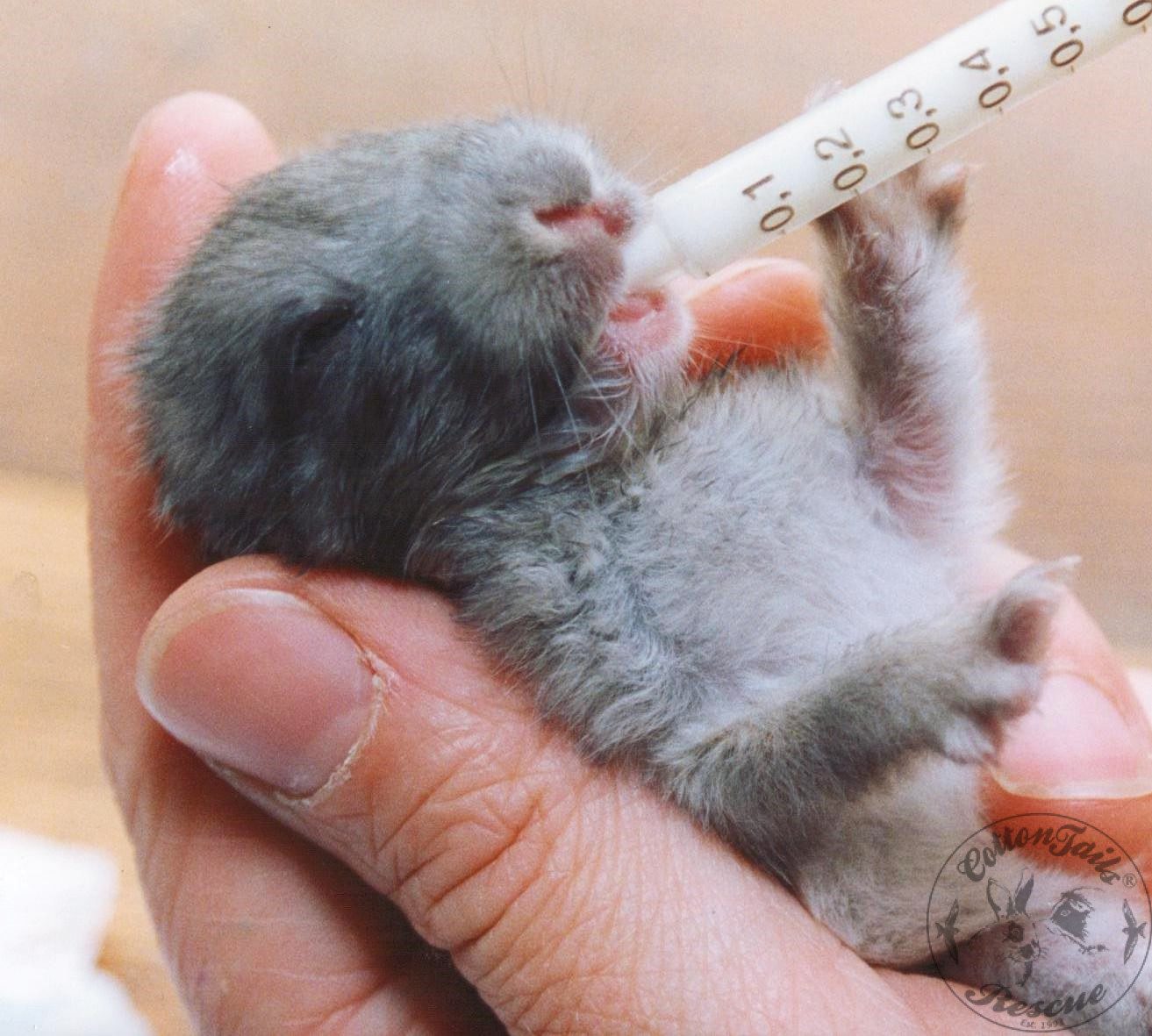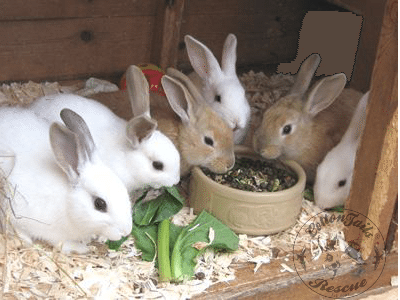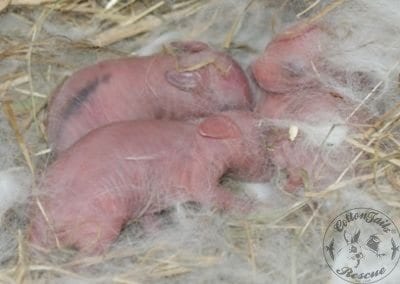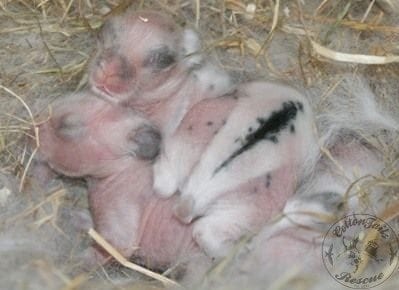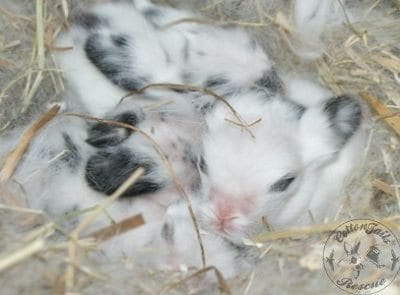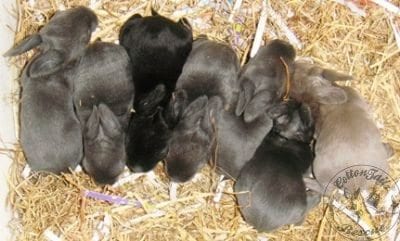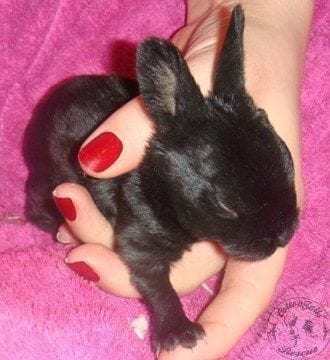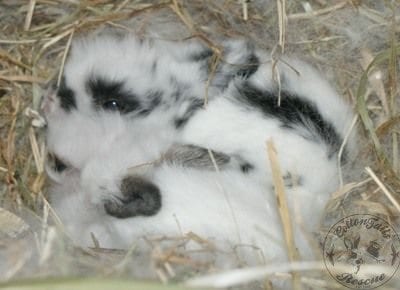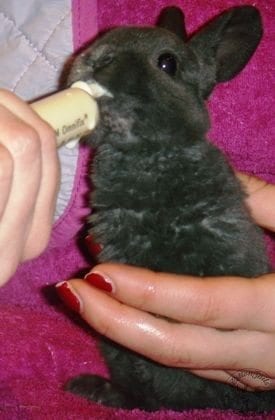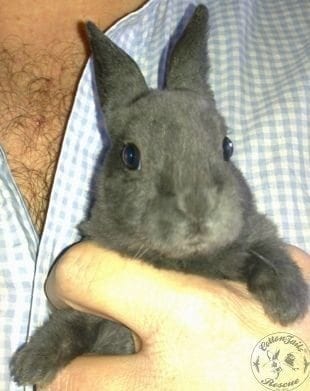Hand Rearing? Read this before you start …
The hand-rearing of baby rabbits is rarely successful if you have not done it before. Experience is essential as the technique differs from that needed for other species. Most baby rabbits die because they accidentally feed too fast, inhaling the milk into the lungs. Sadly, babies affected in this way die from pneumonia within two to three days of accidentally inhaling milk during a feed.
So, before you even consider hand-rearing infant rabbits, you must ensure that this drastic action is justified and essential. If, for example, the babies are orphans, an alternative to hand rearing would be placing the young with another litter if they are only a few days apart.
A common mistake by inexperienced rabbit keepers is to assume that if they don’t see the mother paying regular attention to her litter, she must be rejecting them. Nothing could be further from the truth. Mum only feeds her litter for a few minutes once a day, usually during the night, and she will show no interest in them the rest of the time. This is probably a carry-over from wild rabbit instincts, where it is essential that the mother does not lead predators to the nest site. Therefore, a brief visit once a day increases the chances of survival of the litter.
If a baby accidentally gets carried out of the nest by hanging on to a teat, the mother will make no effort to put it back in the nest. She appears not to recognise the youngster as one of her litter, and sadly, the baby is at high risk of being mutilated or dying from cold unless spotted by the owner and placed back in the nest. There is more on this later.
If you are certain that mum is ignoring the babies (the skin of such babies appears to be too big for their bodies, and they have a wrinkled appearance), but she has milk, you could try holding the mother steady and placing one or two babies at a time underneath her so that they can feed. Let them have a good feed once or twice a day. The stress of this procedure can cause mum’s milk to dry up, but it is worth a try as at least they will have several days of proper milk before the supply dries up. If mum appears to have no milk after 2 – 3 days, an injection given by the vet may resolve the situation.
If mum bunny is successfully managing to feed her babies, but one or two appear to be very small and wrinkly, it is worth taking them out briefly to let them have a separate feed from mum during the day. If this is the only reason they are undernourished, a separate feed once a day for a few days should resolve the issue. If, however, the baby will not respond even to the offer of mum’s teat, there is likely something very wrong, and the baby will likely die. Ensure that the baby is warm before trying to let it feed; if it is cold, it will not respond anyway.
If you find letting the babies feed from mum is going well, do not give additional feeds from a syringe/bottle. This will only confuse the issue as the feeding technique used by the babies is different when feeding from mum compared to being hand-reared, and also, you will upset their appetites as they are usually only fed by mum once a day.
The following is an email that an owner sent me:
My blind rabbit recently had a litter (much to my surprise, as I thought we had two male rabbits!). She didn’t take to the babies very well, which my vet believed was due to her being blind. My vet didn’t hold out much hope of the babies surviving. However, I refused to allow them to die without trying to help. After scouring the internet, I found the advice on your website to be the most useful.
After reading your advice, I tried to avoid hand-rearing them, so instead, I would turn the mother rabbit on her back once/twice a day to allow the babies to feed. The mother was quite content, allowing me to do this successfully. I kept trying to introduce the babies to her because, ultimately, I wanted her to rear them herself.
They have been in my spare bedroom since birth, along with their mother, although separated. This evening, I checked on the litter only to find that they had all crawled into their mother’s cage (a small dog cage, of all things!!), and they were all feeding from her, obviously without any help from me! I felt so proud and just wanted to write a quick note to thank you for the advice you gave on your website. I found it very useful, and I believe it saved the lives of 5 baby lionheads!
If you find one or two babies out of the nest, the chances are high they have been carried out accidentally after a feed on one of mum’s teats, but mum will ignore them (or worse), so it is down to you to get them safely back where they belong. Make sure they are warm before you attempt to return them to the nest, and then, with mum somewhere else, smear them with a small amount of mum’s urine-soaked bedding and place them back with their littermates. Keep mum out for a couple of hours afterwards, and she will be none the wiser. She can be out in her run all day as she only feeds them for a few minutes at night anyway.
Once you are sure that the babies must be hand-reared, ensure you have all the equipment needed for the task and are willing to spare the considerable amount of your time needed to succeed. It is best to assume you will have losses; any that survive are a bonus. If you don’t want to take on this daunting task, contact your local rescue centre or veterinary surgeon in case they can help.
Thankfully, in the wild, nature has decreed that by 31 days old, the babies must be independent due to mum usually having another litter, so at least you know that the intensive care only lasts for just over a month. However, hand-reared babies have special dietary needs until 3-4 months of age (see post-weaning care below). Baby rabbits raised normally by mum usually stay with her for about six weeks, but orphans can sustain themselves from about four and a half weeks onwards. Baby rabbits’ eyes open between 10 and 12 days of age, although they can hear by about the fifth day.
The babies in the photo are 2 hours old.
The hand-rearing of baby wild rabbits is the same, but ultimately, they will need to be rehabilitated and released as the large majority will not be happy in captivity and will constantly try to escape. With this in mind, you must not try to make pets of them, and your only contact should be to clean and feed them. There are more details on this later on.
The only exception to this are individuals that are either permanently damaged in some way that would make survival in the wild not feasible or they become too tame. The carer should ensure the latter does not happen as it is in the best interests of wild babies to safely return to their native environment in the wild.
Milk Formula
Various dried milk formulas are available, and the best one for rabbits is milk for kittens. New versions regularly appear on the market, so I will not list individual brands here apart from Cimicat as this is the brand I have had the most experience with. However, other brands are just as good. Follow the instructions on the container for the correct dilution. Another good alternative is full cream goat’s milk, which is available fresh from most supermarkets. This is especially useful in an emergency when you cannot get hold of the dried kitten milk substitute.
Cimicat milk substitute (powder) – other brands are available and are just as good – made by Petlife International Limited, Bury St. Edmunds, Suffolk, available from most Veterinary Surgeries and online. There are other similar products available.
Avipro Plus (probiotic) or similar product, available from your vet or online. Mum’s milk contains friendly bacteria needed to colonise the baby’s gut to prevent it from being overrun with hostile bacteria that cause diarrhoea and other fatal digestive upsets. A milk substitute does not contain this bacteria, so a probiotic suitable for rabbits is important and should be added to every feed. This should be continued until the rabbit is about five months old. Only add the probiotic powder to the milk just before you feed the babies, as it will ferment if left in warm milk for more than a few minutes.
Droppings from another rabbit – a pointless exercise. The basis behind the suggestion is that the caecotrophs (the droppings that the rabbit eats directly from the anus) do contain relatively high levels of friendly bacteria and other nutrients, but as the rabbit eats them directly from its bottom without them touching the floor, you will not, with a healthy rabbit, usually find any of these to collect! Normal droppings (the ones you typically see in the hutch) have been through the rabbit twice and contain relatively little bacteria and nutrients so are completely useless. You are far better off adding a proper probiotic specially made for the job, as suggested above.
Equipment Required
Box (high-sided or with lid, allow for the passage of air and daylight) lined with a towel (or dust-extracted wood shavings) and hay on top, placed in a warm area (important for newborns). This will need to be swapped for a larger, more suitable cage as the babies grow and become more active, such as a plastic indoor cage sold in most pet shops. If the mother managed to pull fur to line the nest, it is a good idea to use this to help keep newborn babies warm. Change the bedding daily or as required. You will also need another smaller box during the feeding routine (see below).
Not essential but valuable is a mug/cup warmer, which keeps the milk warm throughout the feeding regime (which can take quite a while, depending on how many babies there are). Be careful not to let the milk get too hot; however, the smaller the volume of milk, the quicker it will heat up, so you may need to put the cup on and off the warmer to keep the temperature just right.
Methods of foster-feeding
By syringe – 1ml syringe (available from your vet, chemist shop or online); 2ml syringe for rabbits over three weeks old and feeding well. This size is more challenging to use as it is harder to control the volume of milk consumed at one time. I prefer to use 1 ml syringes throughout, although the process takes longer as you have to refill more often. It can be helpful to use a teat from Catac Products (see below) attached to the end of the syringe, but remember to put a hole in the teat with a hot needle so the milk can come out.
By “bottle” – foster feeding set (Catac Products https://catac.co.uk/product-category/small-pets), and extra teats (small, ST1).
For the experienced handler only, nasal gastric tubing (Kruuse UK ) can be a life-saving extra – attach the tubing to a 5ml syringe and cut the tubing to allow a length of about 10cm. Discard the rest of the tubing.
Shallow dish – If the babies are already over two weeks old, offering them the milk in a very shallow dish, such as a jam jar top, is safer. Place the dish on something to raise it about an inch off the floor and encourage the babies to drink by dipping your finger in the milk and smearing some beneath their noses. They should grasp the technique of lapping the milk quickly and let them take as much as they want at feeding time. More on quantities and timings will be discussed later in this article.
Preparation Of Milk Substitute
Follow the instructions on the container for the correct dilution, as formulas vary. If you find the babies develop diarrhoea, stop feeding them milk for 24 hours and offer water only, reintroducing milk again the next day, diluted to half concentration for the next 24-48 hours until the droppings are getting back to normal again.
- 1 part Cimicat/milk substitute: appropriate parts cooled boiled water (follow instructions on the tub).
- ¼ – ½ teaspoon Avipro Plus or the addition of another suitable probiotic at the correct dosage according to instructions on the tub/packet
If adding the probiotic, only make enough for each feed at the time. Between feeds, syringes, teats, and other feeding equipment can be left soaking in a fresh solution of Milton Fluid, rinsing thoroughly before use.
Establishing a Feeding Regime
Newborn babies must be kept reasonably warm until their fur has grown sufficiently (around seven days old). This is especially important for single orphans, although care must be taken not to let them overheat. The babies must always have the option of crawling away from the heat source if needed. However, they must not be able to crawl completely away from the nest area as they may become too cold and die as they will be unable to find their way back.
The younger the baby is, the more difficult it is to hand-rear successfully. There are two main factors responsible for this. Firstly, controlling the amount of milk going into the rabbit’s mouth at a time is very difficult. If care is not taken, it will breathe milk into its lungs (usually confirmed by milk coming out of the nose), resulting in aspiration pneumonia, which is generally fatal. This should not be confused with the accidental intake of milk up the nose instead of into the lungs and back down the nose – the former not usually causing significant damage.
Secondly, baby rabbits need their mother’s milk not only as a source of nourishment but also to supply them with the appropriate gut bacteria to digest their food (milk) properly. Without this, they fail to thrive, develop diarrhoea and die. This is why probiotics are added to the milk substitute with every feed. If mum has fed the babies for at least a week, their guts will already contain the bacteria they need, but they will still need the probiotic to keep them colonised correctly from that point on. It is common for hand-reared babies to have poor tolerance to changes in diet or the addition of fresh food such as vegetables.
Although the mother rabbit only feeds her babies briefly once a day, the milk being fed during hand-rearing is only a substitute. It is not as rich as the “real thing”, and therefore, you need to feed the orphans 3 or 4 times a day, spacing the feeding times as evenly as possible. It is unnecessary to feed them during the night unless they are not feeding well, in which case you need to feed them every few hours until they take a few mls at a time. The quantity of milk taken varies from infant to infant and from one feed to another.
The guide below is compiled from a study I carried out when hand-rearing two litters of six orphaned babies each to show how much you can expect a baby to take daily. While weighing individual babies is helpful to indicate whether their weight is increasing steadily, the actual weight should not be compared with other charts as individuals vary enormously in weight depending on breed, litter size, and general health, making such comparisons meaningless. You are aiming for a slow (although sometimes inconsistent) weight increase.
The following amounts are for guidance only. Actual amounts may vary depending on breed, general health, and when you started hand rearing. They are NOT minimum or maximum amounts; they are just a guide.
- A 1 day old baby rabbit would consume on average 2 mls of milk daily.
- By 5 days the volume increases to about 12 ml.
- At 10 days it increases again to about 15 mls.
- By 15 days increasing to about 22 mls.
- By 20 days increasing to about 27 mls.
- By 25 days to about 30 mls.
- By 30 days of age you will expect to see a decline to about 20 mls.
- By 35 days a rapid decline to less than 5 mls or weaned altogether.
Baby rabbits can take 2-3 days to settle into a feeding pattern. If there are several to be hand-reared, it is beneficial to feed all babies once, placing each one in the smaller box after feeding as you go along to ensure that you don’t miss anyone, and then “go round again” to make sure they have all had enough to last until the next feed. It is common for a baby who has only taken a small amount at the first “sitting” to be very greedy at the next. Again, replace the babies one at a time into their “home” cage after having their second feed.
They should look content and “full”, the milk in the stomach being visible through the skin in very young babies. The appearance of nice round, full bellies should not be confused with “bloat”, a severe condition caused by the gut becoming static and with the resulting build-up of gases. A rabbit with bloat will not feed normally and, in the latter stages, will not eat or drink at all. Immediate assistance from an experienced vet is essential, but sadly, this condition is often fatal.
It is essential to wipe the babies mouths and chins directly after feeding to prevent any milk from sticking to their skin and causing sores. The damp, warm conditions are ideal for fungal infections around the mouth and chin area, causing the fur to fall out and the skin to go red and sore. Wiping with a non-scented baby wipe will keep the area clean and dry after each feed.
The babies in the photo below are three days old, but the thickness of the fur can vary depending on the rabbit’s breed.
The milk should be warm but not hot (test it by putting a few drops on the back of your hand). Hold the infant with one hand whilst gently inserting the teat or syringe into the mouth with the other. They often wriggle around and jump whilst feeding, so don’t drop them!
If the babies are under six days old, you usually will need to stimulate urination. This is a straightforward task. After feeding each baby, wet a finger or cotton bud in warm water and gently tap or stroke the genital area. Have a tissue ready! Some babies, however, manage to urinate independently from the start, so if you get no results after several attempts at each feed, it is likely because they are managing independently.
Also, be aware that the droppings can sometimes accumulate around the tail area and cause a blockage, with serious consequences if not attended to immediately. Gently wipe away the accumulation with moistened cotton wool to allow the baby to pass droppings normally again. You may find that many droppings are passed immediately after the problem has been cleared! Ensure you keep the mouth and chin area clean and dry after each feed. This is very important. Otherwise, the fur will start falling out around the mouth due to a fungal infection.
The babies in the photos below are 11 days old:
The babies in the photo immediately below are 12 days old, and in the lower photo, the baby is 16 days old (photos supplied by Robbie and Adele Taylor):
By three weeks of age, the babies will start to nibble on hay, followed shortly afterwards by eating small amounts of rabbit food – this does not apply to wild rabbits – for wild rabbit advice, see below. Use a good brand of food, such as Burgess Excel Junior. At this point, you will need to introduce a water bottle at a suitable height so they can reach it, enabling them to drink ad-lib. The quantities eaten will gradually increase until about 4½ weeks, when you should find that they will no longer want milk feeds at all. If you have one or two babies who are still enjoying the milk routine, gradually wean them off by cutting out one feed daily every few days until they receive no milk.
It is common for hand-reared babies to have poor tolerance to changes in diet or the sudden addition of fresh food such as vegetables. It is very disheartening to successfully hand-rear young rabbits to lose them at ten or more weeks old due to sudden changing the diet. Vegetables such as celery, spring greens and broccoli can be given, but this must be done extremely slowly, and by this, I mean a thumb-nail-sized piece of celery per litter to start with, and gradually over a period of weeks, increase the levels and variety. I never give carrot or apple to young baby rabbits, especially hand-reared ones.
In some cases, it is best to hold off introducing fresh food until the babies are at least four months old, and even then, it must be introduced very gradually. The only exception to this rule is if hand-rearing wild rabbits, as in these circumstances, they must be offered a wide variety of grasses and other plants that they would typically find in the wild from about three weeks onwards. Stick rigidly to one type of good quality dried food, and if there has to be a change at any stage, mix the two foods for at least a couple of weeks, gradually increasing the new variety until the changeover has been made.
Very little (if any) dried food should be offered to baby wild rabbits, as giving them as natural a diet as possible will aid in their rehabilitation for release in the wild.
The following film may be helpful:
Wild rabbits – For obvious reasons, wild rabbits should not be fed dried pellet food as they will not find any of this when released back into the wild. Instead, once they start to nibble on hay at around three weeks old, they should be offered fresh grass and other common plants that a wild rabbit could find in their natural habitat. As they will not find a water bottle in the wild either, you should offer fresh water in a small shallow bowl where they won’t go paddling. The rest of the handrearing advice can be followed as above and below, bearing in mind they will ultimately have to be released.
Tube Feeding (for experienced handlers only)
Tube feeding (passing a tube from the mouth to the stomach) should only be attempted if suitably skilled to carry out the procedure, as severe injury could result. It is, however, a very useful technique for very weak infants who have no energy or lack the will to feed. Nasal gastric tubing (see above for specifications) suitably lubricated and attached to a 5ml syringe provides an efficient method of feeding such individuals in the short term, aiming for a volume of about 2 mls for newborns and increasing the volume for older babies appropriately.
The babies in the photo below are 15 days old:
The two photos below are of a rabbit four weeks old (photos supplied by Robbie and Adele Taylor)
Post-weaning care
As mentioned earlier, hand-reared baby rabbits are more prone to digestive upsets than mother-reared babies, and it is vitally important to stick rigidly to the type of feed used and not to introduce fresh food suddenly or wait until at least four months of age. Post-weaning enteritis (mucoid enteropathy) usually kills within hours and appears to be brought on by a change of pH (change of acidity/alkalinity) in the gut, resulting in the overgrowth of “hostile” bacteria such as Clostridia and E. coli, which replaces the natural “friendly” bacteria.
Absorption and digestion are, therefore, adversely affected, resulting in bloat and/or diarrhoea, dehydration and death. Stress can also be important in triggering post-weaning enteritis, so care must be taken to keep this to a minimum, especially is the rabbit is re-homed under four months old. See the article on mucoid enteritis elsewhere on the website.
When weaning wild rabbits, it is important to remember what their typical diet would be if they were still living in the wild, so instead of introducing dried food, introduce grass and other vegetation, as mentioned above. Hay must always be available. Water should be offered in a shallow bowl, not a bottle. Your aim with wild babies (once they are weaned and ready) is to house them outside in a safe run with a hutch attached; your only contact with them is to provide food, water (in a shallow bowl) and bedding and to clean out their hutch.
Within a couple of weeks, every time you set foot in the garden to attend to them, they should immediately run into their hutch to hide. This is good news and means you can start planning where they can be safely released. Make sure that when you put them outside initially, there is not too much of a temperature difference between where they were living inside and the outside temperature. If it is early in the year, you must harden them off gradually before leaving them outside permanently.
Please do not be selfish about wild rabbits and be tempted to try to make pets of them. They are wild creatures with powerful instincts, and it is extremely rare for a truly wild rabbit to be happy in captivity. If you can’t bear to rehabilitate and release it, give it to a wildlife centre, which will do the process for you.

